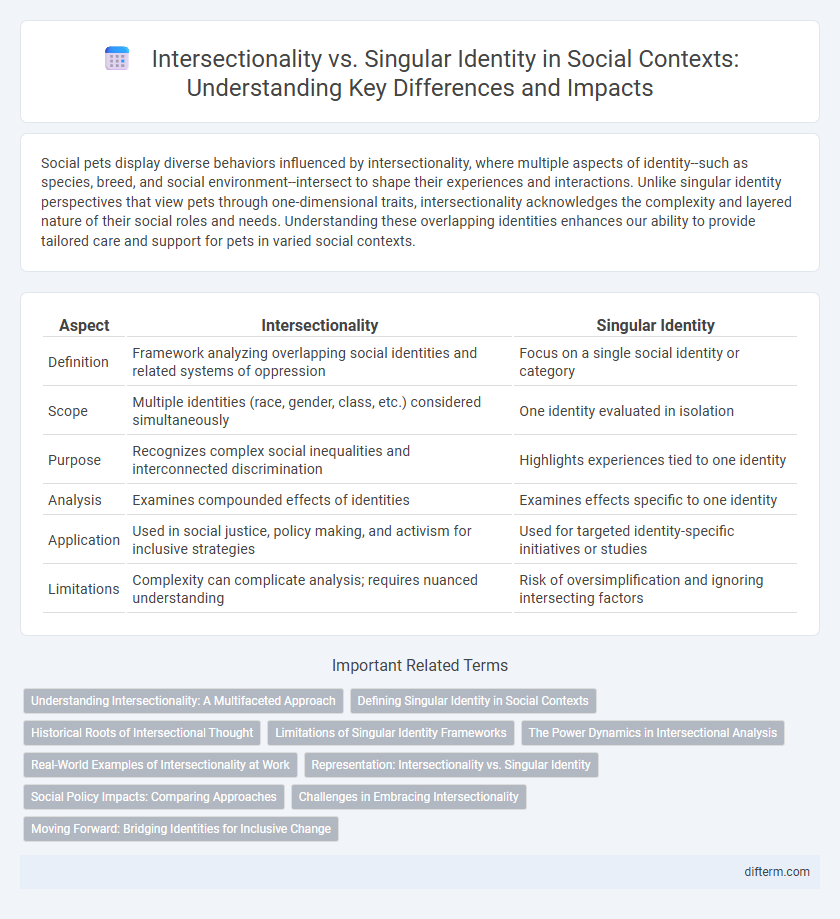Social pets display diverse behaviors influenced by intersectionality, where multiple aspects of identity--such as species, breed, and social environment--intersect to shape their experiences and interactions. Unlike singular identity perspectives that view pets through one-dimensional traits, intersectionality acknowledges the complexity and layered nature of their social roles and needs. Understanding these overlapping identities enhances our ability to provide tailored care and support for pets in varied social contexts.
Table of Comparison
| Aspect | Intersectionality | Singular Identity |
|---|---|---|
| Definition | Framework analyzing overlapping social identities and related systems of oppression | Focus on a single social identity or category |
| Scope | Multiple identities (race, gender, class, etc.) considered simultaneously | One identity evaluated in isolation |
| Purpose | Recognizes complex social inequalities and interconnected discrimination | Highlights experiences tied to one identity |
| Analysis | Examines compounded effects of identities | Examines effects specific to one identity |
| Application | Used in social justice, policy making, and activism for inclusive strategies | Used for targeted identity-specific initiatives or studies |
| Limitations | Complexity can complicate analysis; requires nuanced understanding | Risk of oversimplification and ignoring intersecting factors |
Understanding Intersectionality: A Multifaceted Approach
Intersectionality explores how overlapping social identities, such as race, gender, and class, create unique experiences of discrimination and privilege. Unlike singular identity frameworks, it recognizes the complexity of individuals' social positions and challenges simplistic categorizations. This multifaceted approach enhances social justice efforts by addressing interconnected systemic inequalities simultaneously.
Defining Singular Identity in Social Contexts
Singular identity in social contexts refers to the classification of individuals based on one primary characteristic, such as race, gender, or class, without considering overlapping social factors. This approach simplifies social identity to a single dimension, often overlooking the complexity and interconnected nature of multiple identity components. Recognizing singular identity can lead to generalized assumptions, ignoring how diverse social experiences shape individual perspectives.
Historical Roots of Intersectional Thought
Intersectionality traces its historical roots to Black feminist scholars like Kimberle Crenshaw, who highlighted the limitations of analyzing oppression through singular identity categories such as race or gender alone. Early activists and theorists such as Sojourner Truth and the Combahee River Collective emphasized how overlapping social identities compound experiences of discrimination and marginalization. This framework challenges singular identity approaches by revealing the multidimensional nature of social inequalities embedded in historical systems of power.
Limitations of Singular Identity Frameworks
Singular identity frameworks often overlook the complex and interconnected nature of social identities, which intersectionality addresses by examining how race, gender, class, and other factors intersect to shape individual experiences. These limited frameworks can reinforce stereotypes and marginalize those whose identities do not fit neatly into one category, leading to incomplete or inaccurate understandings of social issues. Intersectionality provides a more nuanced analysis by recognizing multiple dimensions of identity, promoting inclusivity and equity in social research and policy.
The Power Dynamics in Intersectional Analysis
Intersectional analysis reveals how overlapping identities such as race, gender, and class create complex power dynamics that singular identity frameworks often overlook. Power operates not in isolation but through the interlocking systems of oppression that affect individuals differently based on their unique social positions. Understanding these intersections is critical for addressing systemic inequality and fostering inclusive social policies.
Real-World Examples of Intersectionality at Work
Intersectionality reveals how overlapping social identities such as race, gender, and class uniquely shape individual experiences of discrimination, exemplified by Black women facing both racial and gender biases in the workplace. Real-world examples include healthcare disparities where Latina women encounter barriers related to ethnicity and gender, resulting in unequal treatment. Understanding intersectionality informs policies that address complex social inequities beyond single-axis identity frameworks.
Representation: Intersectionality vs. Singular Identity
Representation that embraces intersectionality captures the complex experiences of individuals who belong to multiple marginalized groups, leading to more inclusive and authentic narratives. Singular identity frameworks often oversimplify social realities, rendering invisible the unique challenges faced by those at the crossroads of race, gender, class, and other identities. Emphasizing intersectional representation enhances social equity by acknowledging diversity within communities and combating one-dimensional portrayals.
Social Policy Impacts: Comparing Approaches
Intersectionality-driven social policies address overlapping systems of oppression, enhancing inclusivity and effectiveness by recognizing diverse, intersecting identities. Singular identity frameworks may simplify policy implementation but risk overlooking complex social dynamics, leading to inadequate support for marginalized groups. Empirical studies show intersectional approaches reduce disparities more effectively by tailoring interventions to the multifaceted nature of social inequality.
Challenges in Embracing Intersectionality
Navigating the complexity of intersectionality presents challenges due to overlapping social identities such as race, gender, and class, which often lead to unique experiences of discrimination not fully addressed by singular identity frameworks. Social systems and institutions tend to categorize individuals into isolated identities, making it difficult to recognize and address multifaceted forms of oppression simultaneously. This fragmentation can hinder advocacy efforts and policy development aimed at inclusivity and equity for diverse populations.
Moving Forward: Bridging Identities for Inclusive Change
Bridging intersectionality and singular identity fosters inclusive change by recognizing the complexity of overlapping social categories such as race, gender, and class. Emphasizing shared experiences and collective action enables advocacy that addresses multifaceted discrimination and systemic inequality. Embracing intersectionality in policy-making and community-building empowers marginalized groups through holistic representation and social justice initiatives.
Intersectionality vs Singular Identity Infographic

 difterm.com
difterm.com